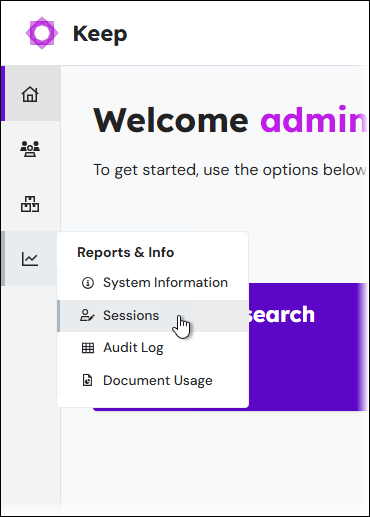- Print
- PDF
The Active Sessions page enables you to see which users and clients are currently logged in to Keep. You can see information about each active session, and you can delete sessions to log users and clients out of Keep.
Note
This page contains draft documentation for beta software. Until the final release of Lasernet Keep 11.0, the content on this page is subject to revision.
Navigate to the Active Sessions Page
To access the Active Sessions page, click Reports & Info in the admin menu, then select Sessions.

Review the Currently Active Sessions
The information on the Active Sessions page enables you to understand:
How many connections to Keep are currently open.
Who is currently logged in and where they are logged in from.
When each session was last active.
.png)
The Active Users tile (see 1 in the image above) shows you how many users are currently logged in to Keep.
The Active Sessions tile (2) shows you how many connections to Keep are currently open. Each connection to Keep is a session. So, for example, if a particular user logs in to Keep from the web browser on their computer and also from the browser on their mobile phone, Active Users increases by 1 and Active Sessions increases by 2.
The session table (3) lists all active sessions. By default, the table columns include:
Username. This is the identity that the user’s Keep session was established under.
Session Type.
A device Address.
A Last Active timestamp.
To add or remove columns from the table, click Show/Hide Columns (4). If you use this tool, you can add the following columns:
Server Name. This column identifies the server that the installation of Keep (that the user logged into) is running on.
User Agent. This column describes the user’s device and web browser.
To filter the table by session type, use the session types list (5):
REST API only: Users connected through the Keep user interface or through an integration that uses the Keep REST API.
Browser only: Users connected through a legacy user interface.
Other only: Non-REST integrations.
Delete Current Sessions
To log a user out of Keep, delete their session. If they try to continue using Keep, they are routed to the log-in page.
.png)
To delete one particular session, click Delete in that row (see 1 in the image above).
To delete multiple sessions in one action, select the checkboxes in those rows (2), then click Delete Selected (3). Click the checkbox in the header row (4) to select all selectable checkboxes.
Note
The checkboxes in rows that contain a Username of Admin are grayed because you cannot delete your own session.


